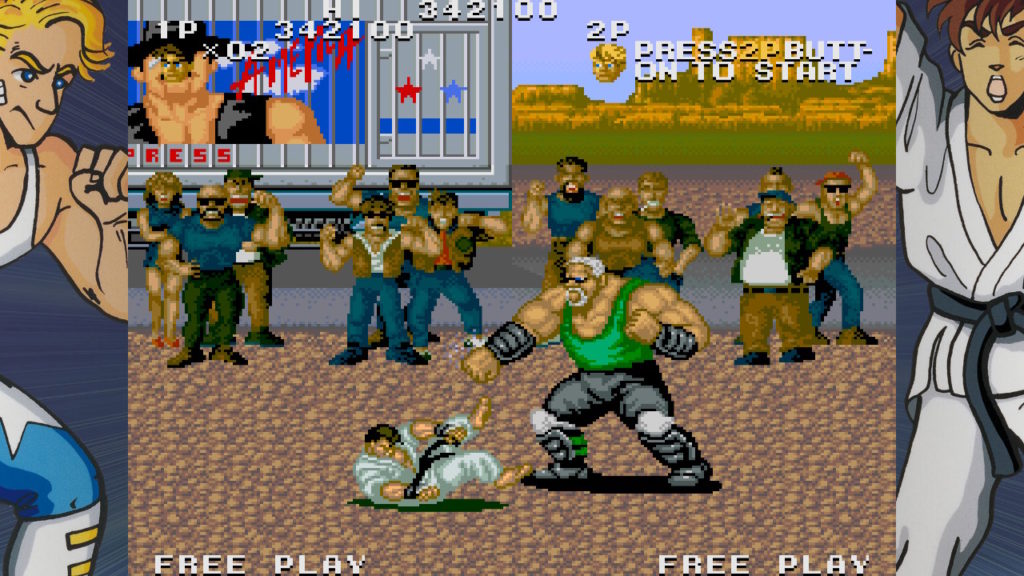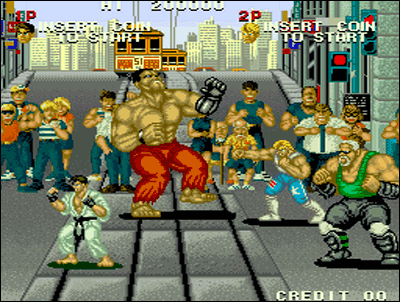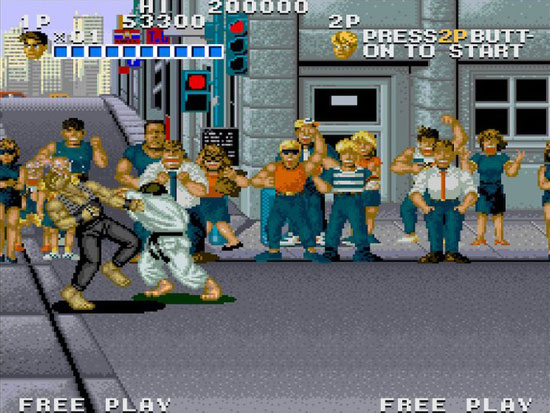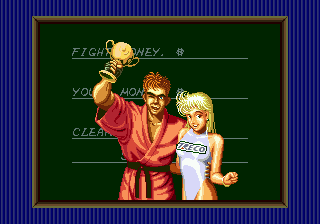Street Smart

REVIEW:
Street Smart is an arcade / beat-em-up fighting game developed and released by SNK/Treco in August 1989. Like other "beat-em-ups" of the era (Double Dragon, Final Fight), Street Smart allows the player to move in all eight directions on the screen. However, unlike those games, Street Smart
keeps the action condensed within an enclosed arena —
comparable to a more traditional fighting game like Street Fighter.
|

|
|
Scott
Steiner AKA Big Poppa Pump is in this game!
|
The player can choose to fight as "Karate Man" — the resident martial arts expert, or "Crusher" — an American, blonde-haired fighter. In 1-player mode, the player will brawl against 8 unique opponents in succession. If two players enter the
game, they will automatically team-up to fight the opponent but will inevitably have what is
called a "Grudge Match" in the next round to determine who receives a Life Bonus / Points. Two players can play through the entire game together
 FUN FACT:
While Street Smart's main protagonist "Karate Man" has been compared to Ryo and Takuma Sakazaki, he has no official connection to them. Karate Man has also appeared in some SNK illustrations over the years, including HIROAKI's cover art for
SNK Characters 2: All About Illustrations.
FUN FACT:
While Street Smart's main protagonist "Karate Man" has been compared to Ryo and Takuma Sakazaki, he has no official connection to them. Karate Man has also appeared in some SNK illustrations over the years, including HIROAKI's cover art for
SNK Characters 2: All About Illustrations.
|

|
|
Watch out for the
trolleys, guys!
|
Several years after its arcade debut, Street Smart was
ported to the Sega Genesis / Mega Drive in 1991, developed by Treco and published by Sega. The console port is visually condensed and inferior in some ways, compensating with brighter colors and black frames on the top and bottom of the screen. The console port also lacks the simultaneous 2-player Vs. CPU Grudge Match
(instead, players take turns against the CPU opponent). Another difference is "Karate Man" wears a red Gi instead of a white one in the console version.
Both characters have a new spinning "Power Move" in the console version (performed by pressing all 3 buttons at once) which knocks down the enemy but also reduces the player's health. Players also win money after defeating opponents, which changes the outcome of the game's ending (explained in the next paragraph). In the console version, "points"
are awarded to the player after each fight which can be assigned to various character power-ups. The buffs include a larger health meter, faster speed, or more power.
|

|
|
Don't step on
glass... Going barefoot in the street isn't street smart.
|
There are 3 possible endings in the game, depending on how much money the player won. If the player is "broke" at the end of the game, the final image has the hero in rags, sitting in the gutter. If the player won a respectable amount of money, their character is depicted as well dressed alongside a
fancy car and attractive girlfriend. If the player earns a lot of money (usually gained by gambling all winnings on the player to win before each round), he appears in the ending surrounded by 4 women and in a home filled with money.
|

|
|
"Get the money, get the power, get the women." lol
|
|
|

| Page Updated: |
January
12th, 2023 |
| Developer(s): |
SNK Arcade, Treco Genesis/Mega Drive |
| Publisher(s): |
SNK, Treco/Sega, G1M2 |
| Platform(s): |
Arcade, Sega Genesis, Sega Mega Drive, PSN
|
| Release Date(s): |
August 1989
Arcade
1991
 Genesis / Mega Drive
Genesis / Mega Drive
July 19th, 1991
 Genesis / Mega Drive Genesis / Mega Drive
Oct. 18th, 2011
 PSN PSN |
| Characters: |
Karate Man, Crusher, "Slippery" Sam Santana, "Tiptoes" Tommy, Jake "The Wrench", Larry "Legbreaker" Lubinski, Antonio "Crybaby" Palermo, Mike "The Muscle" McDermit, Bobby Brown, Mr. X |
| Related TFG Links: |
Final Fight: Retrospective
|
|
|
|
Featured Video:
|
|
|
| Related Games: |
Fatal
Fury, Yie Ar Kung Fu, International Karate, Street Fighter, Street Fighter
2: The World Warrior,
Art of Fighting, Samurai Shodown,
Aggressor's of Dark Kombat |
|

|
|
Gameplay
Engine
|
5.5 / 10
|
|
Story
/ Theme
|
4.0 / 10
|
|
Overall
Graphics
|
7.0 / 10
|
|
Animation
|
6.0 / 10
|
|
Music
/ Sound Effects
|
4.0 / 10
|
|
Innovation
|
6.0 / 10
|
|
Art Direction
|
7.0 / 10
|
|
Intro / Presentation
|
6.0 / 10
|
|
Replayability / Fun
|
5.5 / 10
|
|
"Ouch" Factor
|
6.0 / 10
|
|
Characters
|
4.5 / 10
|
|
BOTTOM LINE
|
6.0
/
10
|
|
Review based on Arcade
version
|
|
| Final
Words: |
Street Smart is one of SNK's earliest beat-em-ups... featuring characters that have long since been forgotten in the dusty vaults of SNK history. Interestingly, Street Smart is one of the few games of the time period that is crossed between "beat-em-up" and "fighting game". To its credit,
it was a pretty unique arcade game in 1989. I remember seeing it at arcades and being impressed by the large character sprites (and the expression on Karate Man's face). 
Before SNK released their first "true" 2D fighting game that you might've heard of, Fatal Fury, Street Smart was mixing it up at cigarette smoke-filled late 80's arcades. It was probably one of the most "gritty" and violent arcade games of the era. While visually impressive in some ways, Street Smart's
actual game mechanics were clunkier than the norm —
and soon to be surpassed by some killer, genre-defining games. (Shoutouts to Final Fight.) For comparison's sake, Capcom could've easily turned Final Fight into a fighting game using the same recipe as Street Smart. (Instead, they made SF2 a couple years later.)
Even so, Street Smart's co-op "Grudge Match" mode was pretty innovative and fun for its time —
a feature that Fatal Fury later used. The ideas introduced in Street Smart were "on the way" to something, but the game lacked pop in the personality department. The generic characters of Street Smart clearly weren't designed with longevity in mind. Will we ever see the return of "Slippery" Sam Santana or Mike "The Muscle" McDermit in another SNK fighting game?  Sadly, I think most of the fighters in this game retired long before the KOF tournament... but
you never know. Sadly, I think most of the fighters in this game retired long before the KOF tournament... but
you never know.
In closing, Street Smart's blatant theme of "fight and gamble to get money / get women / get rich" was also a bit distasteful for the younger gaming audience (especially for the time). And for what it's worth, the representation of a traditional Karate practitioner simply "beating guys up on the street for money" is
against the very principle of Karate. (It wasn't a very wholesome representation of the art if you were into Karate at the time. Just stating facts.) Final Fight, for example, had a far more compelling narrative and theme —
along with future hit fighting games like SF2 and AOF.
~TFG
Webmaster |
@Fighters_Gen
|
|
|
|
|
|
|
|
|